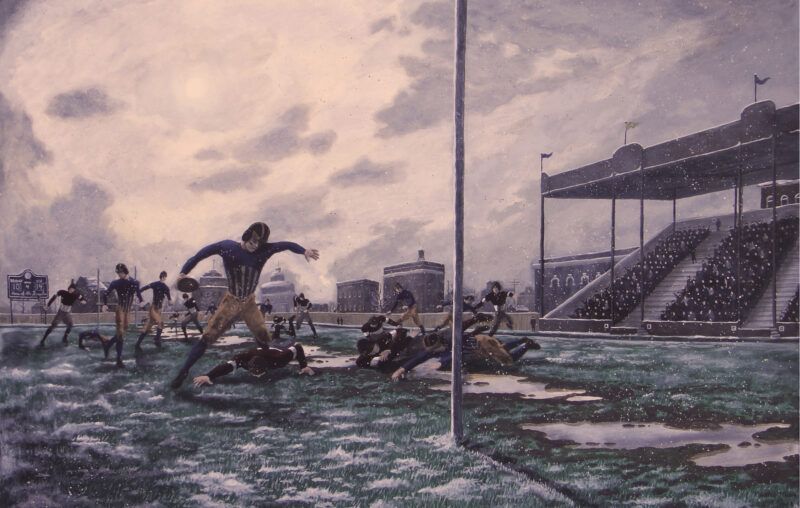The Integration of College Football

By the 1930s, segregation had more or less come to college football. Southern teams were all-white and would only play integrated teams in the South provided they benched their black players. Some Southern teams even demanded that black players be benched when playing outside the South.
This form of segregation was ended one small step at a time during the Civil Rights movement that followed World War II. Unlike major league baseball, where we can point to Jackie Robinson, Branch Rickey and the Brooklyn Dodgers, there was no single event in college football. Rather, there were a series of relatively small steps, and many acts of what I’ll call “calibrated courage.”
The lesson is enormous. Social change can occur through constructive engagement, through a series of small changes each involving a mix of self-interest and appeals to the greater good. In contrast, the resort to force as in a military intervention is, at best, problematic, and often results in push-back and winds up counterproductive.
What follows are some milestones in the integration of college football, with an emphasis on the original major college football bowl games (Rose, Cotton, Sugar and Orange). I focus on the major bowl games because they are supposed to match the very best with the very best, and usually are interregional. After all, it takes a worthy opponent to make a great champion. Three of these bowl games are in the South, where segregation was enforced by law and social pressure.
1916 Rose Bowl: The first of the original major bowl games was integrated when Brown, with one black player, faced Washington State. The integration of the Rose Bowl was hardly an event. California was like an oasis of equality in the country.
1937 (regular season) (at Maryland): Syracuse benches its one black player, Wilmeth Sidat-Singh, to accommodate a demand by Maryland, and loses 13-0. Sidat-Singh later served as a fighter-pilot with the Tuskegee Airmen of World War II. He died in a training accident before being sent overseas.
1938 (regular season) (at Syracuse): Syracuse plays its black player and beats Maryland 53-0.
1940 Cotton Bowl: Boston College accepts a bid from the Cotton Bowl conditioned on its benching its one black player for the game.
1941 Sugar Bowl: Boston College again accepts a bid conditioned on its benching its one black player for the game.
1947 Orange Bowl: The players of Penn State’s football team unanimously reject an invitation from the Orange Bowl on condition that the team not play its two black members.
1947 (regular season game) (at Virginia): Harvard and Virginia play the first integrated football game in the South.
1948 Cotton Bowl: With the approval of the coaches of the Southwest Conference, this became the first integrated bowl game in the South (and the second integrated football game in the South). The game pitted SMU and Penn State, and future NFL Hall of Famers Doak Walker and Wally Tripplett. The game ended in a tie, 13-13.
1949 Sun Bowl: On a vote of the faculty, Lafayette turns down an invitation to the Sun Bowl on condition that it bench its black player.
1950: City of Miami lifts its ban on integrated football games (see the next entry).
1953 Orange Bowl: The Orange Bowl invites Syracuse without conditions. Alabama accepts its invitation thinking Syracuse’s one black player, who had suffered an injury during the regular season, wouldn’t play; and, under orders from the president of the school to leave the field if Syracuse fielded a black player.
1956 Tangerine Bowl: The Tangerine Bowl was, at the time, mostly for mid-sized college football teams, what we would call Division II today. The bowl invites Hillsdale College on condition that it (the college) bench its four black football players. Hillsdale declines the invitation.
1956 Sugar Bowl: The Sugar Bowl invites Pittsburgh without conditions. The other team invited, Georgia Tech, allowed its players to decide whether to accept an offer to play in an integrated football game. The players voted unanimously to accept the invitation. Over protests and threats from segregationists, Pittsburgh (with a black player) plays in the Sugar Bowl.
1959 Liberty Bowl (at Atlantic City, NJ): Criticized both by segregationists back home and integrationists in the north, recently-hired Coach Paul “Bear” Bryant accepts a bid from the Liberty Bowl knowing his team, Alabama, would face an integrated team.
1960 Holiday Bowl (at St. Petersburg, FL): This was the NAIA (small college) National Championship game. It pitted an integrated team from California against an all-white team from North Carolina. The five black players of the California team had to stay at a separate hotel. Nevertheless, the coach said, the team was treated well and would be happy to return.
1963: First black football player in ACC, at Maryland
1966: First black football player in SWC (forerunner of today’s Big 12), at Baylor
1967: First black football players in SEC, at Kentucky
1970: Alabama schedules a home game against Southern California, fully aware that would mean competing against an integrated team. Southern California ran roughshod over Alabama and, the next day, Coach Bryant asked the Board of Trustees to be able to recruit players regardless of color.
1971: First black football players at Alabama, Georgia, LSU and Mississippi.
With the slow process of peaceful social change, things become possible that had previously been impossible, and compromises that at one time had been acceptable, become unacceptable. Social expectations and standards change. Demeaning treatment becomes intolerable; and, then, anything short of equal treatment becomes intolerable. Eventually, it becomes difficult to understand what had been involved in the first place.
Instead of seeing us as having advanced the ball almost the entire length of the field, it becomes easy for some to be fixated on the difference between where we are and an imagined ideal. It also becomes easy to overlook the many acts of calibrated courage that got us to where we are today, and think that force should be used to accelerate the process.










